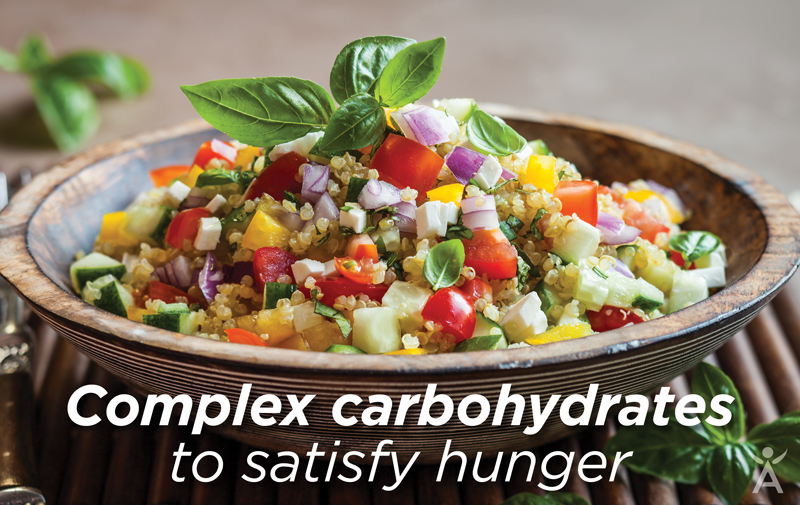 Now that you’re older, does even looking at a bag of potato chips make you feel fat? Do you feel your energy and metabolism crawling to a stop? You’re not alone. A slower metabolism affects the majority of people with age.
Now that you’re older, does even looking at a bag of potato chips make you feel fat? Do you feel your energy and metabolism crawling to a stop? You’re not alone. A slower metabolism affects the majority of people with age.
The good news is there are ways to manipulate metabolism to make it more efficient!
Metabolism is the rate at which food is converted to energy (kilojoules) and used, or burned, by the body. The human body is a complex machine with millions of processes going on at any given time. Each of these requires energy. The faster the body burns through energy, the less likely a person is to gain weight.
One thing to remember is that metabolism is actually the opposite of stagnant – it’s ever-changing. Genetics play a part, but environmental factors also have a large influence. Most environmental factors are ‘short-term boosters’ – meaning they increase your metabolism for a few hours. Certain foods and intense exercise are two examples of these. Conversely, by regularly choosing foods that increase metabolism and working out at a high intensity, ‘short-term boosters’ become ‘long-term boosters’ and metabolism is continuously in high-gear.
1. Raising the metabolism bar
The biggest factor in increasing metabolism? Having more muscle. Since muscle is a metabolically active tissue, the more of it you have, the more energy it takes to maintain it and the more kilojoules you burn. You can think of muscle like a house constantly undergoing construction. Proteins within the muscle are continually being turned over and replaced. All of this uses energy and kilojoules whether you’re in the gym or just sitting on the couch watching your favourite TV show.
Resistance training is key for achieving muscle gains, since this will increase the rate of muscle turn-over and rebuilding (1). If you’re not familiar with the techniques of weight training, it may be best to focus on large muscle groups – chest, back, shoulders, and legs – for maximum metabolism results. In the gym, that means doing exercises that will train these areas specifically, such as the chest press (chest), lat pull down (back), shoulder press (shoulder) and squats (legs).
2. Exercise boost
Apart from resistance training building more muscle, how else can you boost muscle-building and metabolism in the gym? Think intensity. Most people understand that exercise burns kilojoules, but when people associate exercise with fat loss, they generally think of kilojoules they are using in the moment. But the difference between exercise improving your metabolism over the short term (during exercise) as opposed to the long-term is intensity.
Unfortunately, most people often fail to take exercise intensity into account. They go to the gym for an hour or more, participate in Zumba or other aerobic-style classes, or get on the treadmill for their 45 minutes, yet see little changes to their bodies because they’re not exercising hard enough. Exercise intensity not only determines the extent of muscle building and cardiovascular improvements, but it also determines how long and to what extent you’ll burn kilojoules after you finish your workout (2).
The harder the activity, the faster and harder the heart beats to deliver oxygen and blood to muscle. When a person is exercising at 80 percent of their maximum capacity, they are exercising at ‘high intensity’. High-intensity exercise is shown clinically to raise metabolism, likely because it’s more difficult for the body to adapt to the exercise, so you end up burning the maximum amount of kilojoules during and after your workout. If you haven’t already, you should incorporate high-intensity interval training (HIT) into your exercise regimen for metabolism-boosting effects that will last much longer than just during your workout.
3. Muscle-building and thermogenic foods
The best way to support muscle-building for long-term increases in metabolism is to feed your body protein. And you need a high-quality protein such as whey that’s been shown to be more effective for muscle-building than other proteins (3). In fact, foods rich in whey protein have even shown in studies to boost metabolism longer in comparison to other types of protein-rich foods like those containing soy (4).
When foods such as protein boost metabolism they are considered to be thermogenic, which means they require a high amount of kilojoules just to be digested. The more kilojoules used in the digestion process, the less that can be used by the body or stored as fat and metabolism will increase.
In the case of protein, it takes 84 to 126 kilojoules out of every 418 kilojoules you eat of it just to be used on digestion. In comparison, it takes 21 to 42 kilojoules out of every 418 kilojoules of carbohydrate you eat for digestion and 0 to 13 kilojoules for fat (5). Eating meals higher in protein, such as IsaLean™ Pro with 36 grams of protein, will increase metabolism within the few hours following consumption. Another nutrient that achieves this – and is also in IsaLean Pro in a good amount – is fibre, so be sure to choose fibre-rich foods whenever possible.
Its not just protein and fibre that have thermogenic properties, either. Green tea, black tea and yerba mate all contain caffeine along with compounds called catechins that work to raise metabolism. e+ Shot contains both green tea and yerba mate, supporting its ability to assist in weight management (6). Capsaicin, found in chili peppers and cayenne pepper, is another thermogenic compound and is found along with green tea extract in another Isagenix product meant to support weight management, Natural Accelerator™ (7).
If you’re trying to manage your weight and you feel like your metabolism is holding you back, know that conscious hard work can make a difference. Gaining more muscle with the right type of exercise and supporting that muscle with the right kind and amount of protein, along with choosing other thermogenic foods, can rev metabolism back up to high-speed.
References:
- Effect of an acute period of resistance exercise on excess post-exercise oxygen consumption: implications for body mass management. Eur J Appl Physiol. 2002 Mar;86(5):411-7. Epub 2002 Jan 29.
- Børsheim E, Bahr R. Effect of exercise intensity, duration and mode on post-exercise oxygen consumption. Sports Med, 2003;33(14):1037-60.
- Yang Y, Churchward-Venne TA, Burd NA, Breen L, Tarnopolsky MA, Phillips SM. Myofibrillar protein synthesis following ingestion of soy protein isolate at rest and after resistance exercise in elderly men. Nutr Metab (Lond) 2012;9:57.
- Acheson KJ, et al. Protein choices targeting thermogenesis and metabolism. Am J Clin Nutr 2011;93(3): 525-534.
- Ravn AM, Gregersen NT, Christensen R et al. Thermic effect of a meal and appetite in adults: an individual participant data meta-analysis of meal-test trials. Food Nutr Res 2013;57.
- Diepvens K, et al. Obesity and thermogenesis related to the consumption of caffeine, ephedrine, capsaicin, and green tea. Am J Physiol Regul Integr Comp Physiol. 2007;292(1):R77-85.
- Janssens PL, Hursel R, Martens EA, Westerterp-Plantenga MS. Acute effects of capsaicin on energy expenditure and fat oxidation in negative energy balance. PLoS One 2013;8:e67786.





